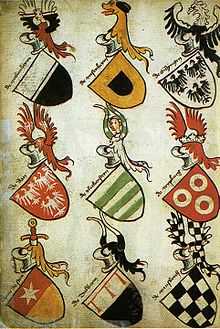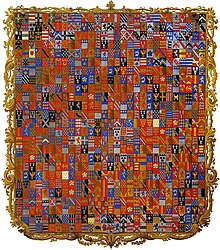WikiProject report
Heraldry and Vexillology





This week, we studied coats of arms and flags with the folks at WikiProject Heraldry and Vexillology. Started in September 2006, the project has grown to include 20 Featured Articles and nearly 50 Good Articles. The project maintains a portal, a list of resources, and a variety of images and templates. We interviewed Wilhelm Meis.
- What motivated you to join WikiProject Heraldry and Vexillology? Does your family have its own coat of arms or flag? Do you have any formal training in these fields?
- I have always been interested in the Middle Ages, knights, castles, and the sport and pageantry of the joust. Heraldry is an important part of that world.
- The question of my family (or any family) having its own coat of arms is a complex one to answer. A lot of vendors are quick to sell nice presentations of dubious armory based on a database of burgher arms by surname, without any evidence of descent beyond the coincidence of the customer having the same surname. Some of my ancestors may have been armigerous, but I have no solid evidence either way. I do have my own arms, though, registered with the Society for Creative Anachronism.
- I do not have formal training in the field of heraldry, much less vexillology. Heraldry has been a subject of informal study for me for many years. One of my particular fields of heraldic interest has been the variation seen among different countries/regions, a very colorful subject which is seldom explored in published literature.
- Have you contributed to any of the project's Featured or Good Articles? What are the greatest challenges to improving heraldry and vexillology articles up to Featured status?
- Some of my greatest contributions on English Wikipedia have been at Swedish heraldry, which was listed as a Good Article in July 2009 and was a Featured Article candidate in February 2012. I made 260 of the 424 edits that have been made to that article to date.
- One of the challenges I have found is that the H/V community is such a small group that our articles just don't get the volume of editor traffic seen at most featured articles. One of my frustrations in general is the lack of English-language literature on continental European heraldry, because most English-language writers focus on British heraldry. Fortunately for me, I can read German and Swedish too, so I have been able to read some of those sources as well.
- Do seals and other emblems receive the same treatment as coats of arms and flags? How different are these from the logos and wordmarks of businesses and organizations? Has it been difficult to keep track of so many different types of symbols?
- Seals played an important role in the development of the practice of heraldry in medieval Europe, and in some ways they are treated very similarly to coats of arms. While seals are not the same as coats of arms, I do consider them to be relevant to the study and practice of heraldry.
- Many modern corporate logos represent a natural development of earlier seals. While many early seals incorporated a natural likeness of their bearer, the development of heraldry gave rise to medieval seals bearing totemic representations. Many corporate logos seen today also incorporate simple monochrome images of abstract symbols. Some modern corporate logos strongly resemble coats of arms (just look at the Porsche, Cadillac and Alfa Romeo logos, for instance), many Japanese companies sport logos resembling Japanese mon badges (see the Mitsubishi logo for a famous example), and some logos resemble seals (Starbucks is a famous example). Some countries, like Iceland, don't have a heraldic authority but do have civic heraldry, so coats of arms are registered as logos and are not held to heraldic standards.
- Differentiating among coats of arms, seals, logos and other emblems has proven controversial at times, particularly in countries that had coats of arms during their colonial times but have moved away from European heraldic traditions with their post-independence national emblems.
- Are the national and state symbols of some countries better represented than others on Wikipedia? What can be done to improve coverage of these neglected parts of the world?
- Generally, European and North American state symbols are more dealt with in more detail than some others, particularly African and Asian ones. This has been especially true in past years, but the situation is gradually improving. Again, I think part of the problem here is the comparative lack of English-language sources treating these subjects. One way editors could help is for those who are able to find and read non-English sources to contribute information from these to Wikipedia's relevant heraldic articles.
- Has the project ever received requests for help with personal genealogical matters? How does the project handle these questions? What other resources are available online and offline for people researching their family histories?
- We do see these kind of requests come up from time to time on heraldic article talk pages. They are generally answered with a reference to WP:NOTFORUM, i.e., Wikipedia's article talk pages are not places to ask general questions about heraldry, but to discuss the improvement of the related article. There are lots of resources out there, more than ever before, for people to be able to trace their lineage. For reliability of resources, I would suggest avoiding any of the bucket shops, but instead start with a genealogy service (there are several well-known ones online and advertising on TV), review the primary source documents showing lineage, and then check the records of any relevant heraldic authorities for specific names, checking that dates are also consistent with the lifetimes of any armigerous individuals found in your family tree. Finally, do not presume that the presence of an armiger among your ancestors entitles you to assume their arms. In some cases, some heraldic elements may be assumed, but you should apply to the heraldic authority in question for specific guidance.
- Does the project deal with any copyright and trademark issues in relation to heraldry and vexillology subjects? Are most of the project's images taken straight from their sources or are they recreated in a vector format?
- We deal with copyright issues as well as some other legal restrictions. Not only are the images themselves subject to copyright law, but the underlying heraldic/vexillological designs are often subject to restrictions as well. Most of the h/v images I have worked with are user-generated vector graphics from WM Commons, usually redrawn from the blazon. One way interested graphic artists could help the project would be by creating or improving vector versions of flags and coats of arms. If these vector graphics are released under a Creative Commons license, it allows us to use them in ways that we can't use non-free graphics (like a .jpg or .gif image borrowed from a government web site under a Fair Use rationale).
- The words and phrases used to describe coats of arms and flags almost seem like an entirely different language. Where can the average Wikipedia reader turn for help in deciphering these descriptions? Has the project found it difficult to make heraldry and vexillology articles accessible to all readers?
- The jargon for English heraldic descriptions is called a blazon. It is based on the Anglo-Norman language that served as the language of law in England at the time of the development of heraldry during the Middle Ages. Many continental European heraldic authorities do not use a special jargon, a rigid grammatical structure, or a stilted register to describe coats of arms, though some do. I understand that Irish and French heraldic descriptions, for instance, use a formal register, but Danish and Swedish ones do not.
- Some resources that can help English speakers learn to decipher Anglo-Norman blazon include Pimbley's Dictionary of Heraldry and A Heraldic Primer: Introduction and Table of Contents (Society for Creative Anachronism). A few other general guides that may be helpful to neophytes and continue to be useful references for experienced heraldic editors include A Complete Guide to Heraldry (1909) by Arthur Charles Fox-Davies and The Oxford Guide to Heraldry (1988) by Thomas Woodcock. I also like Heraldry Sources, Symbols and Meaning by Ottfried Neubecker for its less Anglocentric coverage.
- I don't think it's as difficult for the h/v project to make our articles accessible as it may be for some other projects. Mostly, it's just important to avoid presuming that the general reader understands Anglo-Norman blazons, but many of our articles cover non-English heraldry (which avoids the jargon but presents its own set of translation problems). To help guide our editors in how to handle blazons and informal heraldic descriptions, we developed a guideline (WP:BLAZON) to improve our articles' accessibility as well as verifiability.
- What are the project's most urgent needs? How can a new contributor help today?
- I have actually been trying to gauge the current temperature and direction of the project (see WT:HV#Current direction of the HV project). We have a lot of project members quietly working on their own to improve things that don't require much discussion, so it's hard to keep track of what everyone else is working on. One thing I would like to see is a taskforce approach to article improvement, so that a group of h/v project members could work together as a group to rapidly improve an article from B-class to GA or FA.
Next week, we'll revisit an elemental project. Until then, explore our table of periodic WikiProject Reports in the archive.


Discuss this story